
The Plesiosauria or plesiosaurs are an order or clade of extinct Mesozoic marine reptiles, belonging to the Sauropterygia.
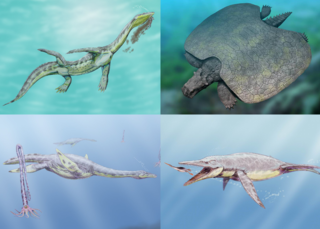
Sauropterygia is an extinct taxon of diverse, aquatic reptiles that developed from terrestrial ancestors soon after the end-Permian extinction and flourished during the Triassic before all except for the Plesiosauria became extinct at the end of that period. The plesiosaurs would continue to diversify until the end of the Mesozoic. Sauropterygians are united by a radical adaptation of their pectoral girdle, adapted to support powerful flipper strokes. Some later sauropterygians, such as the pliosaurs, developed a similar mechanism in their pelvis. It is possible that sauropterygians are a distant relatives of turtles, uniting them under the group pantestudines, although this was still debatable as they can possibly be a stem-archosaur or completely unrelated to both.
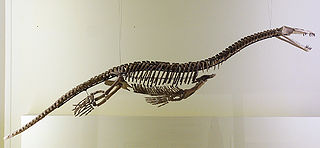
Nothosaurus is an extinct genus of sauropterygian reptile from the Triassic period, approximately 240–210 million years ago, with fossils being distributed from North Africa and Europe to China. It is the best known member of the nothosaur order.

Euryapsida is a polyphyletic group of sauropsids that are distinguished by a single temporal fenestra, an opening behind the orbit, under which the post-orbital and squamosal bones articulate. They are different from Synapsida, which also have a single opening behind the orbit, by the placement of the fenestra. In synapsids, this opening is below the articulation of the post-orbital and squamosal bones. It is now commonly believed that euryapsids are in fact diapsids that lost the lower temporal fenestra. Euryapsids are usually considered entirely extinct, although turtles might be part of the sauropterygian clade while other authors disagree. Euryapsida may also be a synonym of Sauropterygia sensu lato.

Cryptoclidus is a genus of plesiosaur reptile from the Middle Jurassic period of England, France, and Cuba.
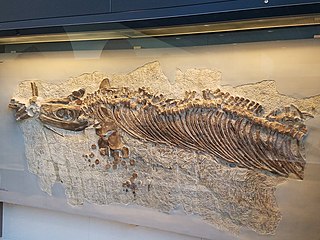
Cymbospondylus is an extinct genus of large ichthyosaurs, of which it is among the oldest representatives, that lived during the Anisian stage of the Middle Triassic in what are now North America and Europe. The first known fossils of this taxon are a set of more or less complete vertebrae which were discovered in the 19th century in various mountain ranges of Nevada, in the United States, before being named and described by Joseph Leidy in 1868. It is in the beginning of the 20th century that more complete fossils were discovered through several expeditions launched by the University of California, and described in more detail by John Campbell Merriam in 1908, thus visualizing the overall anatomy of the animal. While many species have been assigned to the genus, only five are recognized as valid, the others being considered synonymous, doubtful or belonging to other genera. Cymbospondylus was formerly classified as a representative of the Shastasauridae, but more recent studies consider it to be more basal, view as the type genus of the Cymbospondylidae.

Pistosaurus is an extinct genus of aquatic sauropterygian reptile closely related to plesiosaurs. Fossils have been found in France and Germany, and date to the Middle Triassic. It contains a single species, Pistosaurus longaevus. Pistosaurus is known as the oldest "subaquatic flying" reptile on earth.
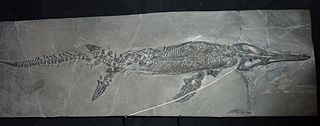
Mixosaurus is an extinct genus of Middle Triassic ichthyosaur. Its fossils have been found near the Italy–Switzerland border and in South China.
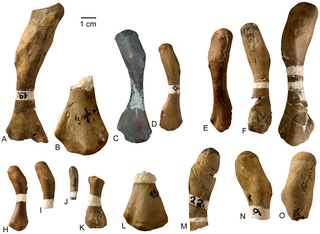
Cymatosaurus is an extinct genus of pistosauroid or nothosauriform sauropterygian. It is known to have been alive from the Early Triassic to the Middle Triassic period of Germany and they seem to originate from the Netherlands. It was small to medium-sized for an eosauropterygian, measuring 1–1.2 metres (3.3–3.9 ft) long.
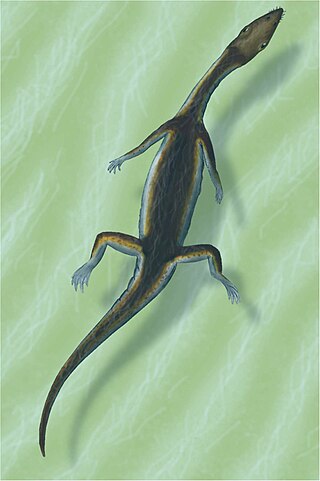
Serpianosaurus is an extinct genus of pachypleurosaurs known from the Middle Triassic deposits of Switzerland and Germany. It was a small reptile, with the type specimen of S. mirigiolensis measuring 75 cm (2.46 ft) long.

Phalarodon is an extinct genus of mixosaurid ichthyosaur known from the Middle Triassic. Its name is derived from the Greek φάλαρα (phálara) and odon ("tooth"). The genus has had a tumultuous history since its classification in 1910, with different workers describing species under different genera or declaring the genus to be a nomen dubium. Currently three species are recognized, but more have been identified in the past.
The Guanling Formation is a Middle Triassic geologic formation in southwestern China.

Sinosaurosphargis is an extinct genus of basal marine saurosphargid reptile known from the Middle Triassic Guanling Formation of Yunnan and Guizhou Provinces, southwestern China. It contains a single species, Sinosaurosphargis yunguiensis.
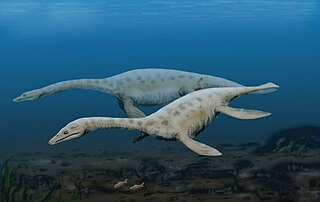
Pistosauroidea is a group of marine reptiles within the superorder Sauropterygia that first appeared in the latter part of the Early Triassic and were the ancestors of plesiosaurs. Pistosauroids are rare in Triassic marine assemblages, and are represented by only a few fossils from central Europe, the United States, and China. Recent phylogenetic analyses consider the Triassic pistosauroids to be a paraphyletic grouping, meaning that they do not form a true clade. Plesiosauria is now placed within Pistosauroidea, while the traditional pistosauroids are successively more basal, or primitive, sauropterygians.
Largocephalosaurus is an extinct genus of basal saurosphargid, a marine reptile known from the Middle Triassic Guanling Formation of Yunnan and Guizhou Provinces, southwestern China. It contains a type species, Largocephalosaurus polycarpon, and a second species L. qianensis.

Thalattoarchon is a genus of large, Middle Triassic predatory ichthyosaur from North America, containing the single species T. saurophagis. The taxon was described in 2013 from a single specimen discovered in the Favret Formation in Nevada. The generic name, meaning "ruler of the seas", refers to its status as an apex predator, while the specific epithet, meaning "lizard eater", alludes to its carnivorous diet. The classification of this genus within the ichthyosaurs is much debated, being either classified within the clade Merriamosauria or in the more basal family Cymbospondylidae.

This timeline of plesiosaur research is a chronologically ordered list of important fossil discoveries, controversies of interpretation, taxonomic revisions, and cultural portrayals of plesiosaurs, an order of marine reptiles that flourished during the Mesozoic Era. The first scientifically documented plesiosaur fossils were discovered during the early 19th century by Mary Anning. Plesiosaurs were actually discovered and described before dinosaurs. They were also among the first animals to be featured in artistic reconstructions of the ancient world, and therefore among the earliest prehistoric creatures to attract the attention of the lay public. Plesiosaurs were originally thought to be a kind of primitive transitional form between marine life and terrestrial reptiles. However, now plesiosaurs are recognized as highly derived marine reptiles descended from terrestrial ancestors.

Silvestrosaurus is an extinct aquatic genus of lariosaurine nothosaurid sauropterygian known from the Middle Triassic of Monte San Giorgio, southern Switzerland. It contains a single species, Silvestrosaurus buzzii, originally considered to be a species of the closely related Lariosaurus. The species was named by Tschanz in 1989, based solely on the holotype PIMUZ T/2804 comprising the skull, the lower jaw, and a dis-articulated partial postcranial skeleton. Cyamodus hildegardis tooth bearing elements were found in the stomach region of the specimen. The holotype was collected at Punkt 902 of Monte San Giorgio, from layer 97 of the Grenzbitumen zone, dating to the Anisian-Ladinian boundary of the Middle Triassic. Kuhn-Schnyner (1990) reassigned the species to its own genus, creating the combination S. buzzii. The generic name honors a church near the collection locality of the holotype, dedicated to Saint Sylvester, a Pope during the reign of Constantine the Great, and from Greek saurus, meaning "lizard", a common suffix for genus names of extinct reptile.

Saurosphargidae is an extinct family of marine reptiles known from the Early Triassic and early Middle Triassic of Europe and China.
This list of fossil reptiles described in 2019 is a list of new taxa of fossil reptiles that were described during the year 2019, as well as other significant discoveries and events related to reptile paleontology that occurred in 2019.

























